
The intracellular region of the Notch ligand Jagged-1 gains
partial structure upon binding to synthetic membranes
Matija Popovic, Alfredo De Biasio, Alessandro Pintar and Sa
´ndor Pongor
Protein Structure and Bioinformatics Group, International Centre for Genetic Engineering and Biotechnology (ICGEB), Padriciano,
Trieste, Italy
Ligands to Notch receptors [1,2] are type I membrane
spanning proteins, all sharing a poorly characterized
N-terminal region and a Delta ⁄Serrate ⁄Lag-2 domain,
which are required for receptor binding, a series of
tandem epidermal growth factor-like repeats, a trans-
membrane segment, and a unique cytoplasmic tail of
100–200 amino acids [3]. Five different ligands to
Notch receptors have been identified in mammals,
three orthologs (Delta-1, -3 and -4) of Drosophila
Delta and two orthologs (Jagged-1 and -2) of Droso-
phila Serrate. Although the molecular mechanisms of
ligand specificity are still unclear, evidence from in vivo
studies suggests that each ligand exerts nonredundant
effects. Gene knock-out of Jagged-1 [4] or Delta-1 [5],
heterozygous deletion of Delta-4 [6] or homozygous
mutants in Jagged-2 [7] all lead to severe developmen-
tal defects and embryonic lethality in mice. There is
no significant sequence similarity shared among the
Keywords
membrane ⁄cytoplasm interface; regulated
intramembrane proteolysis; SDS micelles;
phospholipid vesicles; in-cell NMR
Correspondence
A. Pintar and S. Pongor, Protein Structure
and Bioinformatics Group, International
Centre for Genetic Engineering and
Biotechnology (ICGEB), AREA Science Park,
Padriciano 99, I-34012 Trieste, Italy
Fax: +39 040226555
Tel: +39 0403757354
E-mail: pintar@icgeb.org, pongor@icgeb.org
(Received 15 June 2007, revised 8 August
2007, accepted 20 August 2007)
doi:10.1111/j.1742-4658.2007.06053.x
Notch ligands are membrane-spanning proteins made of a large extracellu-
lar region, a transmembrane segment, and a 100–200 residue cytoplasmic
tail. The intracellular region of Jagged-1, one of the five ligands to Notch
receptors in man, mediates protein–protein interactions through the C-ter-
minal PDZ binding motif, is involved in receptor ⁄ligand endocytosis trig-
gered by mono-ubiquitination, and, as a consequence of regulated
intramembrane proteolysis, can be released into the cytosol as a signaling
fragment. The intracellular region of Jagged-1 may then exist in at least
two forms: as a membrane-tethered protein located at the interface between
the membrane and the cytoplasm, and as a soluble nucleocytoplasmic pro-
tein. Here, we report the characterization, in different environments, of a
recombinant protein corresponding to the human Jagged-1 intracellular
region (J1_tmic). In solution, J1_tmic behaves as an intrinsically disordered
protein, but displays a significant helical propensity. In the presence of
SDS micelles and phospholipid vesicles, used to mimick the interface
between the plasma membrane and the cytosol, J1_tmic undergoes a sub-
stantial conformational change. We show that the interaction of J1_tmic
with SDS micelles drives partial helix formation, as measured by circular
dichroism, and that the helical content depends on pH in a reversible man-
ner. An increase in the helical content is observed also in the presence of
vesicles made of negatively charged, but not zwitterionic, phospholipids.
We propose that this partial folding may have implications in the interac-
tions of J1_tmic with its binding partners, as well as in its post-transla-
tional modifications.
Abbreviations
DMPC, 1,2-dimyristoyl-sn-glycero-3-phosphocholine; DMPG, 1,2-dimyristoyl-sn-glycero-3-[phospho-rac-(1-glycerol)] sodium salt; DMPS,
1,2-dimyristoyl-sn-glycero-3-[phospho-L-serine] sodium salt; DSS, 2,2-dimethyl-2-silapentane-5-sulfonate-d
6
sodium salt; HSQC, heteronuclear
single quantum correlation; MRE, mean residue ellipticity; nrmsd, normalized root mean squared deviation of the fit; PDZ, domain present in
PSD-95, Dlg, and ZO-1 ⁄2; RIP, regulated intramembrane proteolysis; TFE, 2,2,2-trifluoroethanol.
FEBS Journal 274 (2007) 5325–5336 ª2007 The Authors Journal compilation ª2007 FEBS 5325







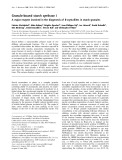

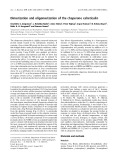
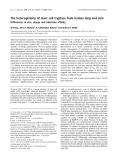
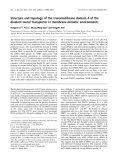
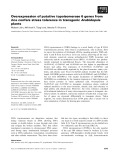
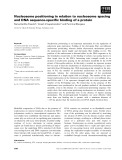
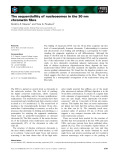




![Báo cáo seminar chuyên ngành Công nghệ hóa học và thực phẩm [Mới nhất]](https://cdn.tailieu.vn/images/document/thumbnail/2025/20250711/hienkelvinzoi@gmail.com/135x160/47051752458701.jpg)










